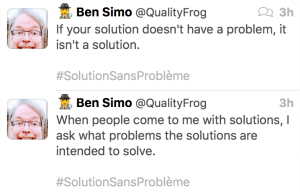Inventing Agile
[Tl;Dr: I invented Agile in UK / Europe, independent of the USA / Snowbird folks, circa 1994].
I was running a project in Europe (Brussels, Belgium) when I first woke up to the value of “process” in delivering working software. It wasn’t the first project I’d been managing, but it was the first time in a corporate environment, with many stakeholders, and with developers and methods not of my own choosing. I have to say that the project was not an unalloyed success.
Upon completing my assignment and returning to England, spurred by my dissatisfaction, I explored the existing literature for ideas about how to do things better. And in my next few assignments I experimented with some of these ideas and began to evolve a coherent approach to software development.
Motivation
I had already long been motivated by a need to see folks able to realise their innate potential. I had often been appalled by the waste of human potential I had seen time and again in places I had worked. I was convinced there must be a better way, and set about finding it.
Influences
Key influences during this time included:
- RAD (Rapid Application Development – James Martin, etc.)
- JAD (Joint Application Development)
- Evolutionary Development (Gilb)
- Rapid Iterative Development
- Risk Management (Capers Jones, etc.)
- TQM (Crosby, Juran, Shingo et al)
- NextSTEP
- Modula-2 (Wirth)
- Eiffel (Meyer)
- Objective-C (Cox)
The Roots of European Agile
By the time I came to work with the CFO of Barclays, running some internal projects at Barclays head office, I had the kernel of an approach that today we’d label “Agile”. This was 1994.
As you may see from the influences listed above, I was already leaving the waterfall / V-model camp and beginning to favour iterative and incremental approaches.
Even in these early days, the results were outstanding.
Continuing to apply and evolve the ways of working I discovered at Barclays, I then did a tour of some of the major merchant banks in the City, where proven ideas for improving their software development results found some favour.
A couple of years later found me at Sun Microsystems’ UK Java Center, bringing these development approaches to Sun’s major corporate clients looking to transition their development teams into the Java ecosystem.
At this time I began referring to my now well-formed approach as “Jerid”.
Note on the Name
Jerid grew out of two complementary initiatives I had been running for some years named “SPEAR” and “BEAR” – Software Process Engineering And Reengineering, and Business process Engineering And Reengineering. SPEAR consisted of many of the techniques I had found useful through years of experimentation and application, packaged into a coherent whole. But SPEAR was more an umbrella concept, with different flavours of specific development approaches underneath – most notably Jerid.
In case you’re wondering, “Jerid” is a kind of javelin (throwing spear) used in games played on horseback in certain Muslim countries in the Middle East. It was also a somewhat convoluted acronym for “Java Enterprise Rapid Iterative Development”. Jerid later evolved into “Javelin”.
The Heart of Jerid
Jerid was founded primarily on ideas from risk management and rapid and evolutionary iterative development. By 1997 it had evolved to a point where, with hindsight, it looked circa 80% like Scrum was to look some years later. Two-week iterations (time boxed), sprints, sprint goals, sprint planning, retrospectives, etc.. I had independently invented “Agile” software development in Europe some years before the name itself was chosen at Snowbird, USA in 2001.
The core difference between Jerid and e.g. USA Agile/Scrum was Jerid’s emphasis on risk management. Jerid projects ensured that the major risks were identified and controlled. For me, this is the essence of any Agile approach – managing and controlling the major risks – both those common to all software development projects and those specific to each individual project.
We continued to apply and evolve Jerid during the late ’90s, at Familiar and its clients, until my departure from Familiar circa 2000.
Since then I have worked with a large number of different companies, large and small, helping them discover the fundamental principles underpinning iterative and agile approaches, and evolving practices and ways of working from those principles.
Acknowledgements
I’m very pleased to be able to acknowledge the contributions made to SPEAR and Jerid by many folks along the way. Although none of this would have happened without my input, their help and support was invaluable to me in evolving my understanding of software development, and later, the intersection of software development and general business.
Disclaimer
I’m pretty sure other folks also invented their own takes on the Agile theme before it became known by that name. Maybe even before I did. I’d be delighted to hear from anyone who believes they fall into that category.
Also please note that many of the strands of the thing that has become known as “Agile” existed long before I even got started in the field of software development methods. We all owe a debt to those many pioneers who were pushing the envelope and challenging accepted wisdom back as far as the 1960s and 1970s, if not before.
– Bob


